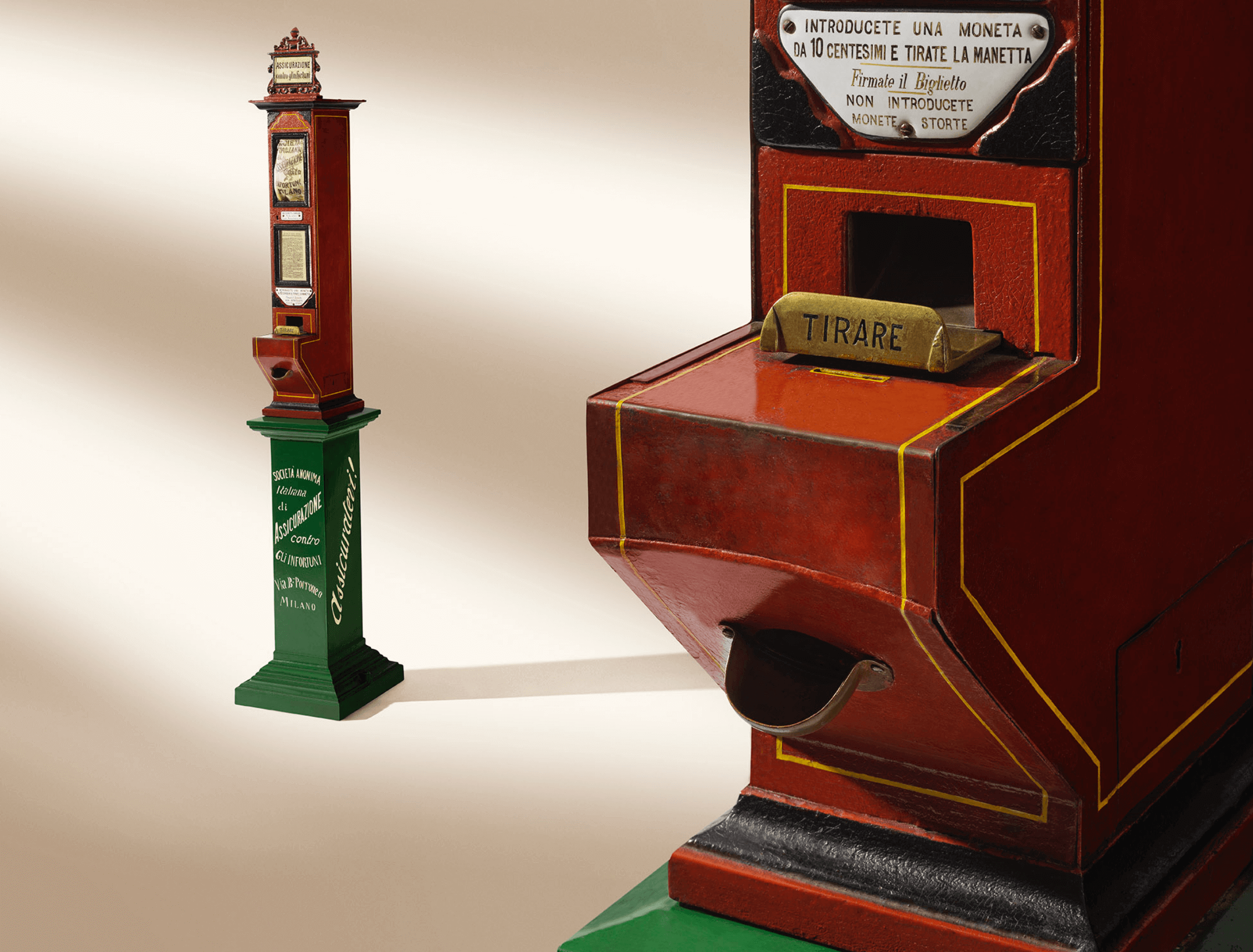Pioneer of on-demand Insurance: 1898, the Insurance Vending Machine
The great universal exhibitions have always been a window on the world: places for comparison and valuable indicators of the degree of development of the exhibiting countries, with their wealth of inventions and mirabilia. Insurance organisations also had the privilege of taking part, because of their prestigious role in economic life, and had every interest in advertising their offers. Generali participated in various exhibitions: first of all, the Italian National Industrial Exhibition in Milan in 1881, followed by those held in Turin in 1884 and 1898. Then there was the Paris Exposition Universelle at the turn of the century and the International Exhibition in Milan in 1906.

Automatic travel policy vending machine (1898)
Assicurazioni Generali Historical Archive
ph. Massimo Gardone
The 1898 Turin exhibition deserves a special mention, not only because it celebrated the fiftieth anniversary of the Albertine Statute, but also because it marked the beginning of sector-based exhibitions, exclusively dedicated to a handful of commercial branches but open to the general public. The goal was clearly achieved, since the exhibition counted more than 8,000 exhibitors and 3.5 million visitors (equal to the population of Sicily at that time).
Generali participated through its subsidiary company Anonima Infortuni, which published a series of manuals for the occasion, illustrating the usefulness of individual accident insurance. But a new, captivating idea was needed, something able to impress the public.
Generali was created in the name of innovation, as in the ability to interpret changes and emerging needs, appropriate them, and turn them into solutions, making use of the best existing technology. So it’s no wonder that, on that particular occasion, it turned to a recently established company, Ceretti & Tanfani in Milan.
The company had made its debut at the United Exhibitions in Milan in 1894, installing a small cable car to transport people within a space dedica<ted to mass entertainment. Literally taken by storm, this ante litteram amusement park housed the water toboggan, or “Niagara Falls”, the roller coaster, the Giordano panorama, the Stigler tower, and indeed the “Aerial Tramway” by Ceretti & Tanfani.
Four years later, in Turin, in partnership with the recently established company, Generali amazed the public with an engineering first: the insurance vending machine. By putting a 10-cent coin into the vending machine, you obtained travel insurance offering the bearer a policy against injuries sustained while travelling by train or steamboat. The policy was valid from the date automatically printed on the ticket and ended at noon the next day.
This was the ancestor of the modern vending machine, a small engineering miracle: a machine that provided a money back guarantee automatically and instantly, without the need for signatures and red tape.
The insurance vending machine perfectly embodied Generali’s attitude to seizing social transformation in the second industrial revolution. Society became “mobile” thanks to the development of railways. And its primary need was an immediate guarantee of insurance cover for travelling.
Generali had the foresight to be the first to acquire the technology of a cutting-edge company and promote it in a specific phase of Italian history – the “industrial revolution” – installing it in Naples – as mentioned by the illustrious writer Matilde Serao in the “Il Mattino” newspaper in May 1899 – as in the country’s main stations, enabling passengers to protect themselves against injuries when travelling.
The travellers, for their part, could afford the investment. One of the specific features of this extraordinary economic “launch”, in fact, was the direct contribution of private savings to companies.
This involved a certain availability of capital and a greater propensity to spend. In the insurance field, for example, Italian spending tripled in the twenty years from 1895 to 1915, growing from 65 to 195 million lire. The Italian quality of life increased hand-in-hand with the demand for insurance protection.
And Generali responded by developing a well-organised set of liability coverage, policies for horse and carriage owners; for transport vehicle businesses; for owners of cars, motorbikes, and bicycles; for owners of steamers and sailing ships; and for owners of boats. Added to this list were policies for tramways and railways, a constant source of accidents and misfortunes, recording, in 1895, 117 dead and 1,168 wounded in England, 42 dead and 188 wounded in Germany, 26 dead and 117 wounded in Prussia, and 15 dead and 245 wounded in Austria. With regard to Italy, passenger insurance was an indication that the railway carried with it a certain degree of risk. It was therefore no coincidence that, on the 1st of June 1896, Anonima Infortuni issued its first third-party liability to the Western Tramway Company of the city and province of Turin.
The experience of vending machines, which came to an end in the 1920s, must be seen in the context of a country that was heading towards full industrialisation. Generali’s choice to operate through specialised companies, of direct interest to the industry, was indicative not only of a technical choice aimed at preserving the life branch from difficult-to-control risks, but also of a new commercial and advertising policy, based on both technological innovation and the strong desire to spread the concept of private insurance among the population.
Marco Besso, who steered the company into the modern era, wrote in his Autobiografia: “Insurance [...] should not be seen as a source of profit for the company but as a fount of moral satisfaction, having to contribute to the wellbeing and tranquillity of families.” And also of those who, for business or pleasure, decided to travel as a family.
